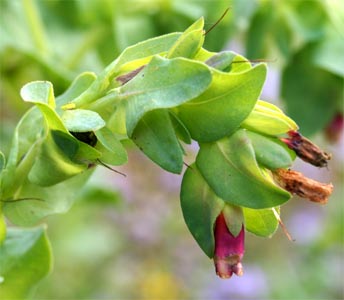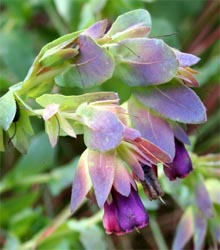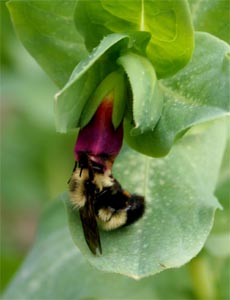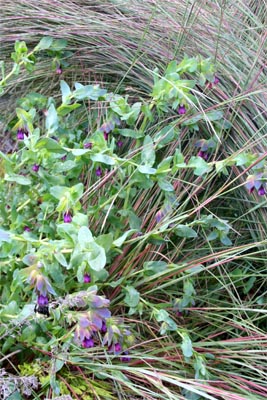
Honeywort, Cerinthe major, is an herbaceous plant native to open meadows and grassy plains of the Mediterranean basin, especially in southern Italy and Greece. The name Cerinthe comes from the Greek keros for wax and anthos for flower, since at one time it was thought bees got wax for their hives from the flowers. This species is an unusual member of the borage family (Boraginaceae) in that it does not have hairy foliage like most family members do. It is variously classified as a hardy annual, a tender evergreen perennial, or a shortlived, half-hardy perennial or biennial. As a Mediterranean plant, its normal habit is to grow in winter, bloom in spring, set seed and die, and then germinate from seed in the fall. In other parts of the country, it is typically grown as a summer annual.

This unusual flower has been grown in gardens since the middle ages but was not prominent in Victorian or Edwardian gardens. Even today it is not commonly offered commercially in the U.S. The plants are not particularly stunning from a distance; the enchanting flowers are best appreciated up close as the coloring is rather subtle. The variety ‘Purpurascens’ is the most commonly available type and was selected for its stronger coloration than the species.
This plant has handsome foliage and colorful bracts that long outlast the small flowers. The rounded, partially perfoliate (leaves encircle the stem) leaves are somewhat fleshy, glaucous (smooth, not hairy), and pale green-gray to blue in color. They arise in whorls along branching stems. The new growth is mottled with white; this marbling fades with age. The leaves get a deeper blue as night temperatures get lower later in the season. Plants vary considerably in size and form depending on the conditions they are grown under. In full sun and rich soils they can grow tall enough (2-4 feet) to require staking to keep them upright. In drier and less fertile soil or in light shade the plants tend to be more compact, reaching only about 18” tall. The foliage remains in good shape until a hard freeze.

The tubular flowers are borne in clusters of two or three surrounded by large, almost heart-shaped, nodding bracts. The one inch long flowers produce honey-flavored nectar, probably leading to its common name. In the wild the species varies greatly in color, with flowers ranging from cream or pale yellow to reddish lavender or purple and the bracts anywhere from dull blue-green to vivid blue or strong purple. As the plant matures, the bracts change from green to purple to blue. In the garden, the bract color is often on the murky side, depending on the light the plant is viewed in. The variety ‘Purpurascens’ has rich purple-blue flowers held inside sea blue bracts. The flowers are attractive to many types of bees and hummingbirds. Deadhead to encourage continued bloom. If you wish to use honeywort as a cut flower, the ends of the stem need to be either flamed or dipped in hot water.
Flowers eventually produce large rounded black seeds with one flat edge. The seeds on a plant do not ripen all at once, but continue to mature throughout the season as they are produced. They are dispersed a considerable distance from the mother plant by an explosive release mechanism.

Honeywort is a great addition to the informal garden. It is a good filler plant, with its blue-green foliage and succulent texture contrasting nicely with other greens in the garden. To bring out the colors in the bracts, interplant honeywort with plants that have purple or bronze leaves, such as Euphorbia dulcis ‘Chameleon’ or dark-leaved Heucheras (such as ‘Cathedral Windows’ or ‘Obsidian’). Honeywort combines nicely with blue, purple and pink flowers, as well as with other plants with blue or silver foliage. It also provides a striking contrast for bright orange-flowered plants, too. It is nice throughout the border, suitable for middle areas where it will stay upright with the support of adjacent plants or in the front where its longer stems can trail down.

Tall arching grasses are good companions that emphasize its cascading lines. Little bluestem (Schizachyrium scoparium ‘The Blues’) echoes the colors of honeywort, especially in the fall. You could even create a miniature meadow with a mixture of honeywort and various other informal annual flowers from seed, such as dark purple or blue cornflower or Bachelor’s button (Centaurea spp.), annual poppies or California poppy (Eschscholzia californica). C. major also grows well in containers, where the plants will drape gracefully over the sides – but they need lots of water and fertilizer to thrive.
Honeywort is easily grown in most soils in full sun to light shade. Once established it is relatively drought tolerant but it becomes fuller and blooms more when well watered (but dislikes overly moist soil). In rich soil, plants develop lush foliage at the expense of flowers.
Start honeywort from seed indoors 4-6 weeks before the average last frost or outdoors in spring after the danger of frost has passed. If starting indoors, the very large seeds should be planted individually in small pots or plugs.

Soaking the seeds overnight before planting will speed germination. Seed can be collected and stored for the following year. Check the ground beneath large plants every few days to collect, gathering the seeds as they fall (if you can see them on the ground) or harvest whole blooming branches, bringing them inside to dry in a paper or cloth bag (to contain the seeds that otherwise would be shot all over when the pods burst). In mild climates, honeywort will reseed readily but in the Midwest, the seeds tend to sprout in the fall and are killed by the first freeze. Volunteer seedlings can be transplanted but they will suffer some transplant shock and will require a few weeks to re-establish.
There are few varieties of honeywort available. ‘Purpurascens’ is the most common variety in nurseries and seed catalogs. It has intense purple flowers with the bracts and sepals in varying shades of bluish-violet. ‘Kiwi Blue’ is also offered occasionally; it has bluer bracts and flowers. ‘Purple Belle’ has magenta flowers and grows 2 feet tall.
Other related species that occasionally are available include:
- C. minor – is smaller, yellow-flowered, and is considered to be a perennial hardy to zone 5.
- C. retorta – from Greece, has dark purple bracts enclosing pale yellow flowers with blue-purple tips. It is even more striking than C. major, with bold, mottled foliage that has dark spots at the tips and around the edges.
– Susan Mahr, University of Wisconsin – Madison





 Marigolds
Marigolds Create a Butterfly Garden
Create a Butterfly Garden Plant Flowers to Encourage Beneficial Insects
Plant Flowers to Encourage Beneficial Insects Forcing Bulbs
Forcing Bulbs


